Your Dog Is The Worst WFH Coworker—Here’s How To Stay Sane
When you purchase through links on our site, we may earn a commission. Here’s how it works.
Your Zoom meeting starts in two minutes. Your dog is barking. You’re sweating.
Table of Contents
We get it: Some days, working from home with a dog feels impossible. Here’s how to survive the madness without losing your mind.
Why Your Dog Is the Worst WFH Coworker (And Also the Cutest)
You thought the loudest coworker would be someone from sales. Instead, it’s the one who barks at squirrels during your 10 a.m. meeting.
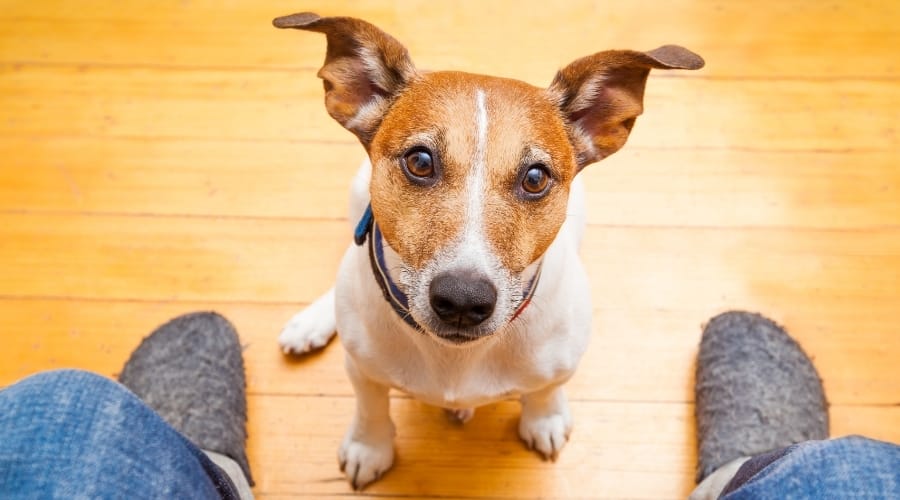
Dogs don’t follow schedules. They don’t understand that your laptop means “not now.”
They chew through cords, photobomb your Zoom calls, and treat every Amazon delivery like a full-scale security breach.
Productivity? Good luck.
And yet, they somehow get away with it. One head tilt or nap at your feet, and you forget they just destroyed your planner.
They might be the worst coworker for your schedule, but they’re surprisingly good for your sanity.
The Barking, Begging, Zoom-Interrupting Survival Guide
You can love your dog and still feel completely overwhelmed by them. Especially when you’re trying to work and they think it’s time to wrestle a squeaky toy.
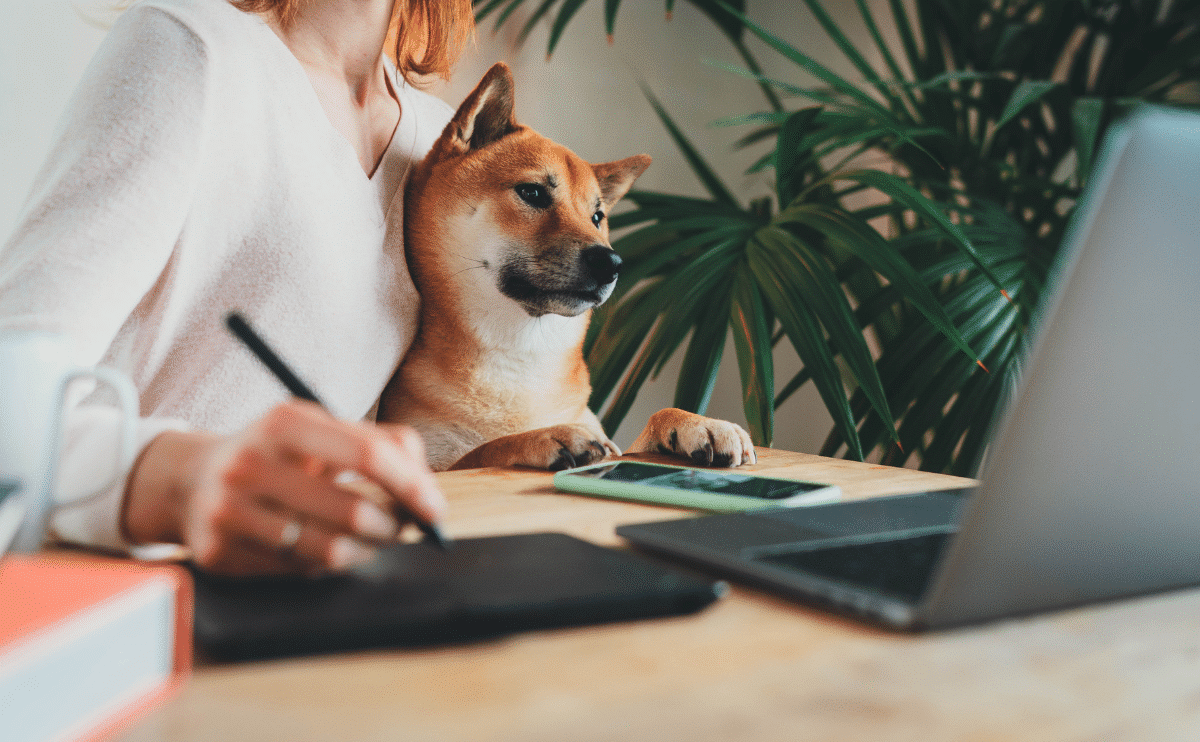
This is where a little strategy goes a long way. Creating a few simple routines and distractions can turn your chaotic coworker into a manageable background character.
Start with timing. A quick game of fetch or walk before your first meeting can take the edge off. Save special toys or treats for times when you need their attention elsewhere, like during video calls or deep work sessions.
If barking is the issue, try closing blinds or setting up a white noise machine. Even small changes can stop the squirrel alerts before they start.
And don’t forget about mental enrichment. Puzzle feeders, snuffle mats, and lick mats can keep your dog occupied and calm longer than most toys.
Working from home with a dog might never be peaceful, but it can be predictable—and that’s a win.
WFH Dog Sanity Checklist
- Walk your dog before your first meeting
- Save special toys or treats for video call times
- Use puzzle toys or lick mats for mental enrichment
- Close the blinds to reduce barking triggers
- Turn on a white noise machine or fan for background calm
- Rotate toys to keep things interesting
- Schedule short play breaks between work blocks
- Give them a “place” to settle near your desk (bed or crate)
Bored Or Just Controlling The Office? Signs Your Dog Runs The Show
Some dogs get restless when you’re working. Others take over your entire routine like they own the place. If your day revolves around their demands, you might be dealing with more than boredom.
Here are a few red flags that your dog has become the boss of your WFH setup:
- You plan meetings around walk times. If your dog gets grumpy when you skip the noon stroll, you’ve officially been scheduled.
- They stare at you until you give up. Not just once, every time you sit down. And somehow, it works.
- Your desk snacks are no longer safe. You now eat with one hand while the other blocks sneaky snout ambushes.
- They know the sound of Slack notifications. And take it as their cue to start barking.
- You’ve moved your chair because they claimed your spot. And you didn’t even argue.
Sure, it’s funny. But it’s also a sign that your dog might need more structure—or at least fewer executive privileges.
How To Gently Take Back Control
- Reinstate a daily routine with fixed walk and meal times
- Ignore demand barking and reward calm behavior instead
- Use a “settle spot” like a bed or crate during work hours
- Rotate enrichment toys to prevent attention-seeking
- Block off focus time and stick to it, even if your dog looks betrayed
How To Keep Your Dog Busy While You Actually Get Stuff Done
When your dog is bored, you get nothing done. That’s why the key to a productive work-from-home day is distraction—strategic, satisfying, dog-approved distraction.
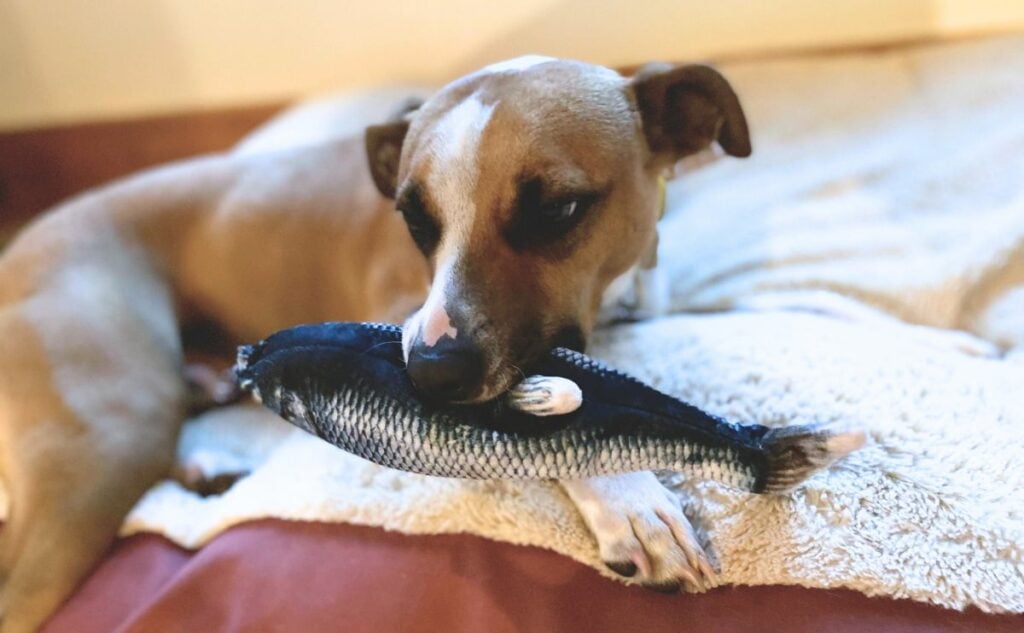
Start with toys that do more than squeak. Interactive toys, treat-dispensing balls, and snuffle mats give your dog something to solve. These work their brain, not just their jaw, which means they stay focused longer.
Rotate your toys. Instead of keeping every toy out all the time, stash a few and bring them out one at a time. The novelty factor keeps things fresh and exciting without spending more money.
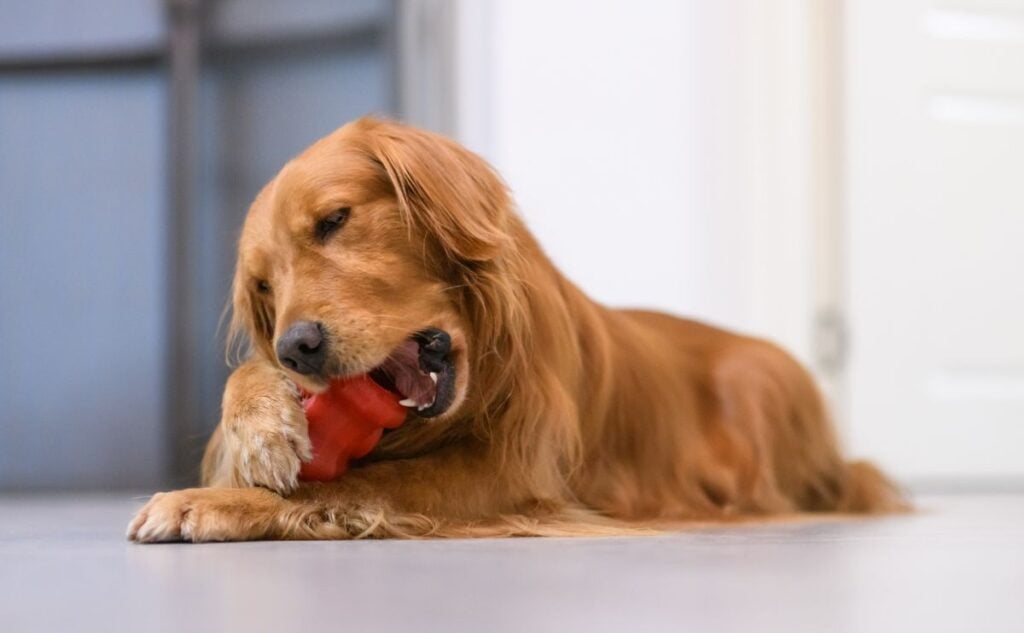
Reserve high-value items for when you need deep focus. Peanut butter-filled Kongs, frozen bone broth cubes, or lick mats with mashed banana can buy you thirty golden minutes of silence.
If your dog prefers movement over food, try a flirt pole, an indoor fetch game, or even a quick hide-and-seek session during breaks. Five minutes of play can reset their energy and give you a clear window to concentrate.
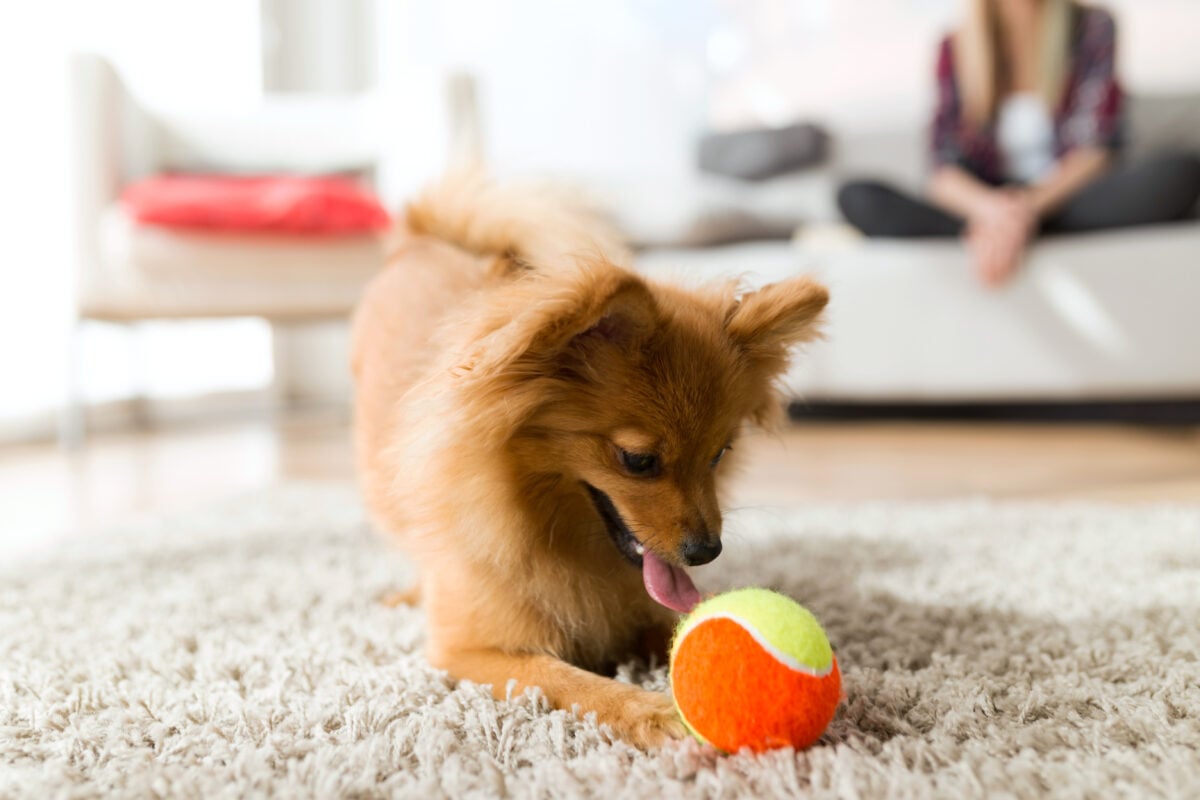
Your WFH Dog Toolkit
Brain Games
Time-Buying Treats
- Kong with frozen filling (e.g., Pet Naturals BusyButter)
- Lick mat with canned food or sweet potato
- Bone broth ice cubes or pup popcicles
Quick Energy Burners
- Indoor fetch with soft toys
- Tug rope with a “drop it” break
- Flirt pole in a hallway or yard
Pro Tip: Only bring out these tools during work blocks to make them extra valuable.
Create A Doggy Desk: Easy Office Setups Your Pup Will Love
If your dog follows you from room to room, they’re not just being clingy. They want to feel like they belong in your workspace. Creating a designated “doggy desk” can help them settle down instead of pacing, whining, or begging for attention.

This doesn’t have to be complicated.
Start with a comfy bed or crate placed near your desk. Add a few favorite toys, a chew, and something that smells like you. That small space becomes their version of your office chair.
Some dogs love having a job. Give them a stuffed toy to “supervise” or a chew they can “review.” The sillier the setup, the more fun it becomes—for both of you.

If you’re on video calls often, keep this setup just out of frame to avoid distractions while still keeping your dog close. A happy, occupied dog is a quiet coworker.
Helpful Tools For A More Peaceful Workday
A few minor upgrades can make a big difference in your daily flow. Here are some dog-friendly essentials that keep things calm, contained, and chew-proof.
- Portable dog gate or pen – Create an easy work zone boundary
- White noise machine – Drowns out barking triggers like mail trucks
- Cord covers – Save your charger from curious chewers
- Cooling or orthopedic bed – Helps older dogs settle longer
Our Personal Experience: Danielle’s WFH Setup
I’ve worked from home for a long time, and I’ve always had a couple of four-legged coworkers on my team. While their company is sweet, their professionalism is… lacking.
There’s no HR department to file a complaint when my senior dog Daisy starts crop-dusting my office. These aren’t just little toots either, they’re “open a window and reconsider your life choices” kind of farts.
Over the years, I’ve developed a few survival strategies to keep the dogs entertained, allowing me to actually get some work done. Turns out, preparation is everything.
I start the day with a brisk walk and potty break for both pups, which usually buys me a few solid hours of peace before lunch rolls around and their needs reboot.
Falkor, my very clingy Poogle, is a full-time distraction if left to his own devices. His favorite trick? Guilt-staring at me until I stop typing. Sometimes with a sly toe lick for good measure.
The solution: long-lasting treat hiding toys. I fill one up, hand it over, and he trots off to his “work zone” to gnaw in blissful silence. Bonus points if I pull out the snuffle mat, he gets a kick out of sniffing out every last kibble crumb, then flinging the whole thing across the room like he’s solved a puzzle and won a prize.
Daisy, on the other hand, is a senior stage-five clinger. She insists on being exactly six inches from me at all times.
If I shift away? Whining. If I try to close a door? Scratching. If I dare move her bed? Emotional devastation.
So now she has a designated bed parked right beside my desk. Every morning she gets a calming treat, settles in with a sigh, and proceeds to snore, stretch, and yes, occasionally unleash a fart powerful enough to make my eyes water and make me rethink having breakfast.
It’s chaotic, smelly, and a little ridiculous, but I wouldn’t trade my furry coworkers for anything.
– Danielle DeGroot, Dog and Cat Mom & Writer at Canine Journal
Sample Schedules That Keep You Both From Losing It
Trying to work with a restless dog is like typing with someone poking your shoulder. A predictable routine helps both of you focus, relax, and avoid constant interruptions.
Not every dog needs the same level of activity. Below is a realistic full-day work schedule that works for most adult dogs, followed by custom options for high-energy pups and puppies.
8-Hour Workday For Adult Dogs
- 7:30 AM – Morning walk (15–30 minutes)
- 8:00 AM – Breakfast + enrichment toy (snuffle mat, Kong)
- 8:30 AM to 10:30 AM – Work Block #1. Dog settles nearby with chew or naps in crate
- 10:30 AM – Potty break + quick game (5–10 minutes)
- 10:45 AM to 12:30 PM – Work Block #2. Use white noise or rotate toys
- 12:30 PM – Lunch + backyard break or short walk
- 1:00 PM to 2:30 PM – Work Block #3. Frozen treat or puzzle toy during this block
- 2:30 PM – Potty break + play break (10–15 minutes)
- 2:45 PM to 5:15 PM – Work Block #4. Dog rests with a chew, nap, or quiet toy
- 5:15 PM – End-of-day walk or outside play

Note: Most adult dogs adjust well to a steady routine, especially if their needs are met early in the day. If your dog still seems restless, try swapping in a higher-effort toy or adding a midday walk. A little flexibility can make a big difference.
For High-Energy Dogs
- 7:00 AM – Long walk or jog
- 8:00 AM – Breakfast + puzzle feeder
- 8:30 AM to 10:00 AM – Work Block #1. Chew toy or snuffle mat nearby
- 10:00 AM – Tug game or flirt pole (10 minutes)
- 10:30 AM to 12:00 PM – Work Block #2. Try white noise or a calming crate setup
- 12:00 PM – Walk, fetch, or short hike
- 1:00 PM to 2:30 PM – Work Block #3. Frozen Kong or supervised toy time
- 2:30 PM – Quick play or mental training
- 3:00 PM to 5:00 PM – Work Block #4. Wind down with a chew or nap in bed
- 5:00 PM – Outdoor decompression walk

Note: High-energy dogs often need more stimulation than you can realistically give during a workday. If you have a fenced yard or use an invisible fence, consider letting them enjoy some safe outdoor time while you work. Just be sure it’s supervised or secure to avoid escape attempts.
For Puppies
- 7:00 AM – Potty break + breakfast
- 7:30 AM – Short play session
- 8:00 AM – Nap in crate
- 9:00 AM – Potty + training game
- 9:30 AM to 10:30 AM – Supervised work time with chew toy
- 10:30 AM – Potty break + light activity
- 11:00 AM – Nap time
- 12:00 PM – Potty break + lunch
- 12:30 PM to 1:30 PM – Quiet play or playpen time near desk
- 2:00 PM to 3:30 PM – Nap time
- 3:30 PM – Potty break + indoor fetch
- 4:00 PM to 5:00 PM – Final work block with quiet toy or chew
- 5:15 PM – Dinner + outside time
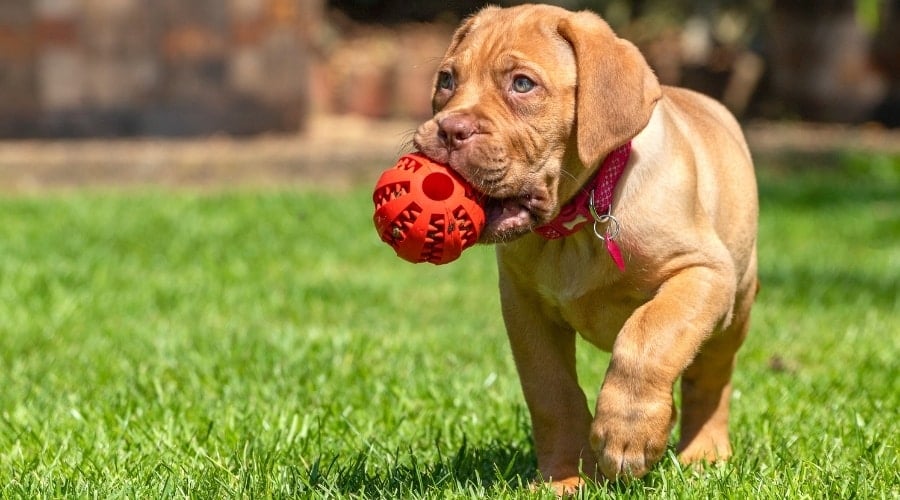
Note: Puppies need frequent potty breaks, short play sessions, and close supervision. It’s normal if your productivity dips during this stage.
Structure helps, but expect some interruptions. This phase passes faster than it feels—hang in there.
Our Personal Experience: Emma’s WFH Rhythm
Working from home with two dogs definitely has its challenges, but sticking to a solid routine keeps everyone happy—especially me!
I start the day with an early morning walk to burn off that initial burst of energy and set a calm tone before I dive into work.
Later, I carve out a dedicated 20-minute play break just for my high-energy Dachshund, who thrives on fun and stimulation. Her favorite? The flirt pole—it’s like doggy cardio in disguise!
These little routines not only help manage their energy but also give me a mental reset, making the whole work-from-home juggle way more manageable.
– Emma Braby, Rescue Dog Mom & Writer at Canine Journal
When It’s Time To Tag In A Pro
Sometimes, no amount of toys, walks, or routines can compete with a dog who needs more than you can give during the workday. That doesn’t mean you’re failing. It means you’re realistic.
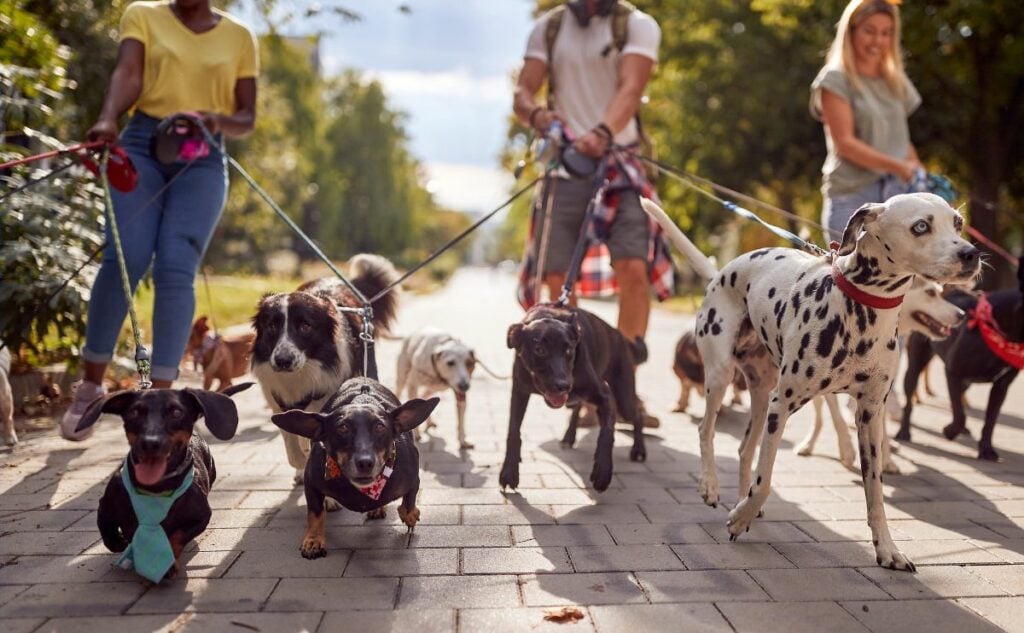
Dog walkers, doggy daycares, and even neighborhood drop-in sitters can make a huge difference, especially for high-energy breeds, working breeds, or puppies in their clingy phase. Even a few hours a week of extra help can restore your sanity and provide your dog with the stimulation they need.
Look for services with flexible scheduling or “half-day” options. Apps like Rover and Wag make it easy to find background-checked walkers or hosts, but local Facebook groups or neighborhood forums often provide great referrals as well.
If you’re lucky, a retired neighbor might even become your dog’s new best friend.
Signs It Might Be Time to Call In Help
- Your dog barks nonstop when left alone during work blocks
- You’re seeing destructive behavior, like chewing furniture or doors
- They won’t settle, even with toys, treats, or a structured routine
- You’re constantly interrupting your work to manage their needs
- You feel burned out, distracted, or overwhelmed most days
- Your dog’s energy level seems higher than ever, even after breaks
WFH Burnout Is Real—For You & Your Dog
It’s easy to feel like you’re failing when your dog is barking, your inbox is full, and you haven’t eaten lunch yet. Working from home with a dog is rewarding, but it’s also exhausting in ways people don’t talk about enough.
Just like you, your dog can burn out, too. Restlessness, whining, or acting out may be signs they’re overstimulated—or just missing your full attention.
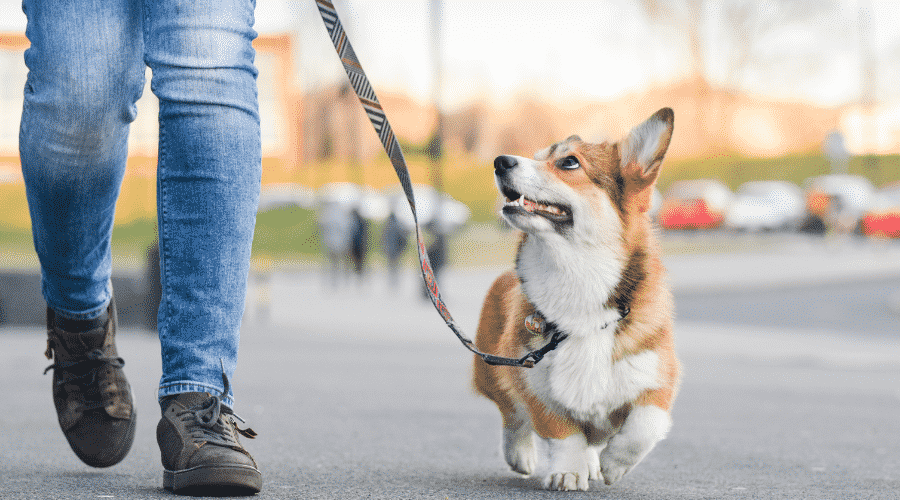
The National Alliance on Mental Health (NAMI) encourages regular breaks and movement-based activities for work-from-home professionals. These steps promote mental health when working at home in an otherwise isolated environment and are also beneficial in an office setting.
Dogs need a total of 30 to 120 minutes of physical activity daily, depending on their breed and age. So, remember that something as simple as a short walk can benefit you and your pet simultaneously.
Frequently Asked Questions
Whether you’re new to working from home with dogs or just trying to survive another Zoom call with a barking sidekick, these are some of the most common questions people have about working from home with dogs. It’s not always easy, but with a little structure and creativity, it can work.
Don’t see your question? Ask us in the comments!
Is Working From Home With Dogs Better Than Leaving Them Alone?
For many dogs, yes. Being at home during the day gives your dog more social time, more consistent potty breaks, and fewer hours of isolation. This can reduce separation anxiety and lead to a calmer, happier dog.
That said, working from home with dogs still requires boundaries. If your dog becomes overstimulated or overly attached to your presence, you’ll need to incorporate solo downtime to prevent future stress when you’re away.
How Do I Keep My Dog Quiet During Zoom Calls?
The key to quiet Zoom calls while working from home with dogs is preparation. Make sure your dog gets a walk, playtime, or enrichment activity before your call begins. A tired dog is much less likely to interrupt your meeting.
You can also set up a calm space with a chew or frozen treat to keep them occupied. For dogs that react to outside triggers, try closing blinds, using white noise, or adding a barrier to block visual distractions.
What If My Dog Won’t Leave Me Alone While I Work?
This is one of the most common struggles when working from home with dogs. If your dog follows you everywhere, begs for attention, or whines constantly, it may be a sign they’re bored—or just used to getting attention on demand.
To reset this dynamic, create a routine that allows them to have their own time and space. A comfy bed near your desk, a few scheduled breaks, and some independent toys can teach them to settle while you focus.
Can Working From Home With Dogs Cause Separation Anxiety?
It can, especially if your dog becomes overly dependent on your constant presence. Dogs thrive on routine, and if they never experience time alone, they may struggle when your schedule changes.
To prevent this, even while working from home with dogs, build in short periods where you’re apart. Let them nap in another room, use a crate for quiet time, or occasionally leave the house without them so they stay confident being alone.
What Are The Best Toys Or Tools For Working From Home With Dogs?
Keeping your dog entertained while you work often comes down to the right gear. Some of the most effective tools for working from home with dogs include puzzle feeders, lick mats, long-lasting chews, and treat-dispensing toys.
These items not only keep your dog busy, but they also provide mental stimulation that tires them out faster than physical play alone. Rotate toys to maintain novelty, and reserve the most exciting ones for moments when you really need to focus.
Separation Anxiety In Dogs
If your dog struggles to be alone—even for a short time—it may be more than boredom. Read our guide to separation anxiety in dogs to learn the signs, causes, and how to help.



